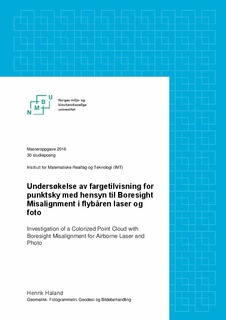| dc.contributor.advisor | Maalen-Johansen, Ivar | |
| dc.contributor.author | Haland, Henrik | |
| dc.date.accessioned | 2017-08-03T12:42:19Z | |
| dc.date.available | 2017-08-03T12:42:19Z | |
| dc.date.issued | 2016 | |
| dc.identifier.uri | http://hdl.handle.net/11250/2449841 | |
| dc.description.abstract | Per idag nnes det ikke en felles metode for hvordan en boresight mellom
kamera og laser kan bli bestemt i y. Teknikker idag benytter seg av erfarne
operatører som justerer individuelle ydde striper og ser når disse passer
best iforhold til nærliggende striper i en etterprosessering. Primært er dette
gjort for ybåren laser alene og ikke for fargelagt punktsky. En annen
metode er å se på laserpunktenes z-koordinat og projisere disse fra bakken
opp til kameraets CCD sensor. På denne måten er laserpunkter blitt
benyttet for å kalibrere yets boresight feil. Teknikkene er likevel avhengige
av stereobildepar der fremskjæring i rommet brukes gjennom
sammenbindingspunkter for dannelsen av en tredimensjonal punktsky.
Resultatene co-registreres og utjevnes på likt for å danne en felles løsning
for laser med foto. Metoden er svært tidkrevende og er lite e ektiv da en
operatør må velge riktige sammenbindingspunkt for å knytte bildene
sammen. En alternativ løsning bør derfor utvikles.
Denne avhandlingen er en undersøkelse av fargelagt punktsky og hvordan
målenøyaktigheten er iforhold til et tradisjonelt ortofoto. I tillegg skal det
undersøkes fargeverdi i hvert punkt og deretter sammenligne disse med
ortofotoets farge på samme piksel. Oppgaven deles opp i to deler der den
første delen ser på fargetilvisningen av punktskyen gjennom å generere
raster og bruke dette som sammenligningsgrunnlag til ortofoto. Den andre
delen er en analyse av hvor mye forskyvingen er observert i bilde for alle
enkeltstriper ydd over testområde sammenlignet med ortofoto.
Data i oppgaven er hentet fra ybåren laser scanning der bilder er tatt
samtidig med scanningen. Kameraet benyttet for å ta bilder er et mindre
type ybåren kamera og har ikke de samme egenskapene som et standard
VEXCEL storformat kamera. Bildene benyttes for drapering av farge på
punktskyen i en etterprosessering. Dataene er fremstilt og levert av Blom
Geomatics AS | nb_NO |
| dc.description.abstract | As of today there is no common calibration method for determination of
boresight misalignment angles between camera and laser in airborne data
aquisition. Techniques today uses experienced operators to adjust each
own strip individually compared to a reference surface in post-processing
techniques. Primarily, this method is used for airborne laser scanning
exclusively and has not yet been considered for colored LiDAR point cloud.
Another method is to look at the laser points z-coordinates and project
them inversely from ground level up to the camera's CCD sensor. In this
way, laser points are been used to calibrate the aircraft boresight errors.
The techniques are nevertheless dependent stereo imaging with forward
intersection used in combination with tie points to form a three-dimensional
point cloud. The solution are been co-registered combined in a bundle least
squares adjustment for both laser and photos simultaneously to nd a
common solution. The method is very time consuming and ine cient
because there is need an experienced operator to select correct and precise
tie points between each photo. Alternative and more e ective solutions
should be developed.
This thesis is a study of colored point cloud and how measurement accuracy
compares to traditional orthophotos. In addition, the examination of color
value of each point are being extracted and then compared to orthophoto
color of the same pixel. The thesis is divided into two parts where the rst
part looks at colorization of point cloud through rasterization and use this
as a basis for comparison to the orthophoto. The second part is an analysis
of how much displacement is observed in the image of all individual strips
own over the test area with respect to the orthophoto.
Data used in the thesis is from airborne laser scanning where photos where
acquired simultaneously with laser scanning. The camera used to take
photos are a small airborne camera and does not have the same
characteristics and capabilities as a standard large format VEXCEL
camera. The images used for draping the color on the point cloud are done
with post-processing techniques. The data is acquired and provided by
Blom Geomatics AS. | nb_NO |
| dc.language.iso | nob | nb_NO |
| dc.publisher | Norwegian University of Life Sciences, Ås | |
| dc.rights | Navngivelse 4.0 Internasjonal | * |
| dc.rights.uri | http://creativecommons.org/licenses/by/4.0/deed.no | * |
| dc.title | Undersøkelse av fargetilvisning for punktsky med hensyn til Boresight Misalignment i flybåren laser og foto | nb_NO |
| dc.title.alternative | Investigation of a Colorized Point Cloud with Boresight Misalignment for Airborne Laser and Photo | nb_NO |
| dc.type | Master thesis | nb_NO |
| dc.subject.nsi | VDP::Matematikk og Naturvitenskap: 400 | nb_NO |
| dc.source.pagenumber | 162 | nb_NO |
| dc.description.localcode | M-GEOM | nb_NO |

